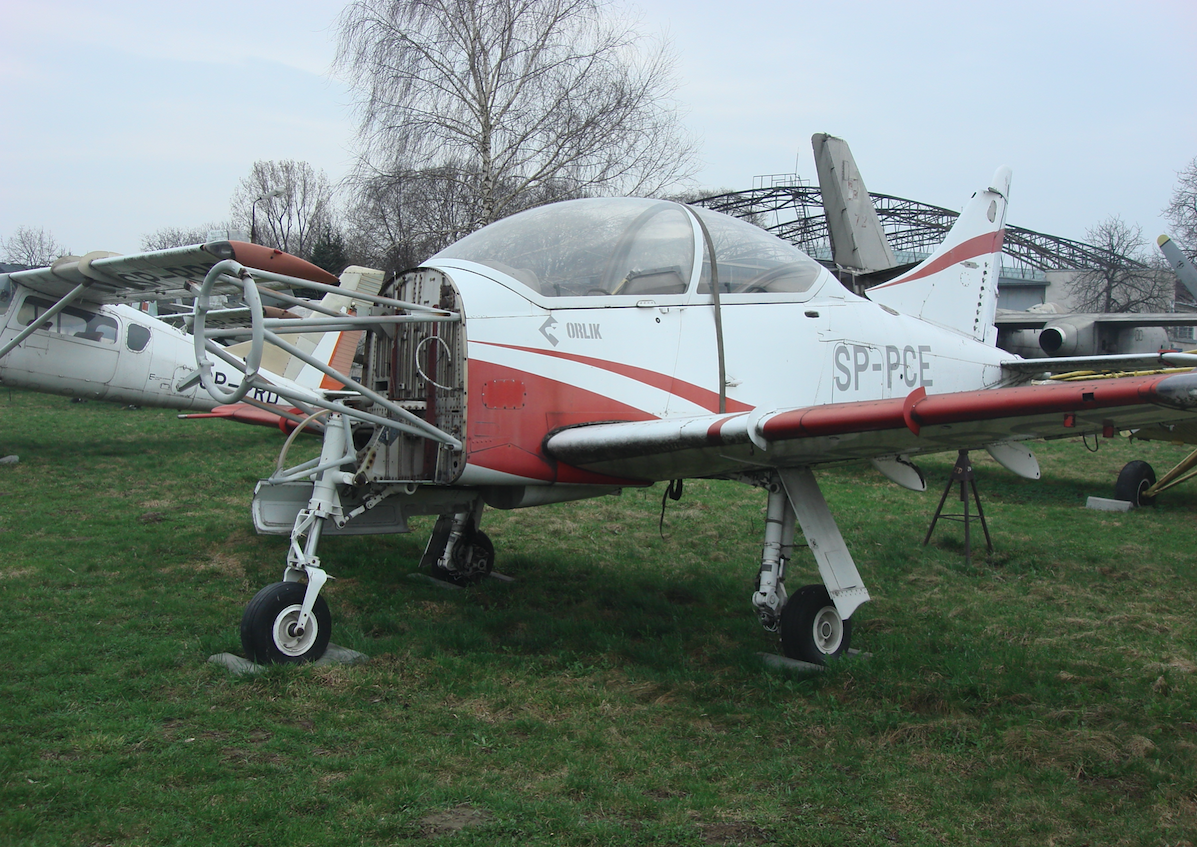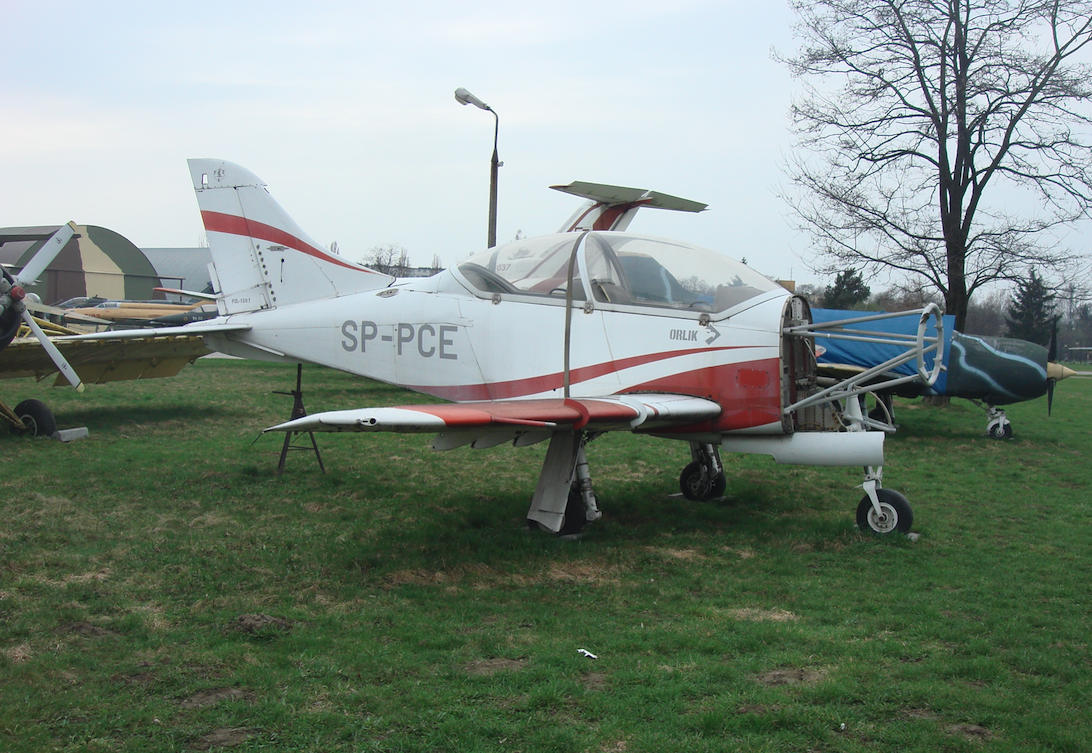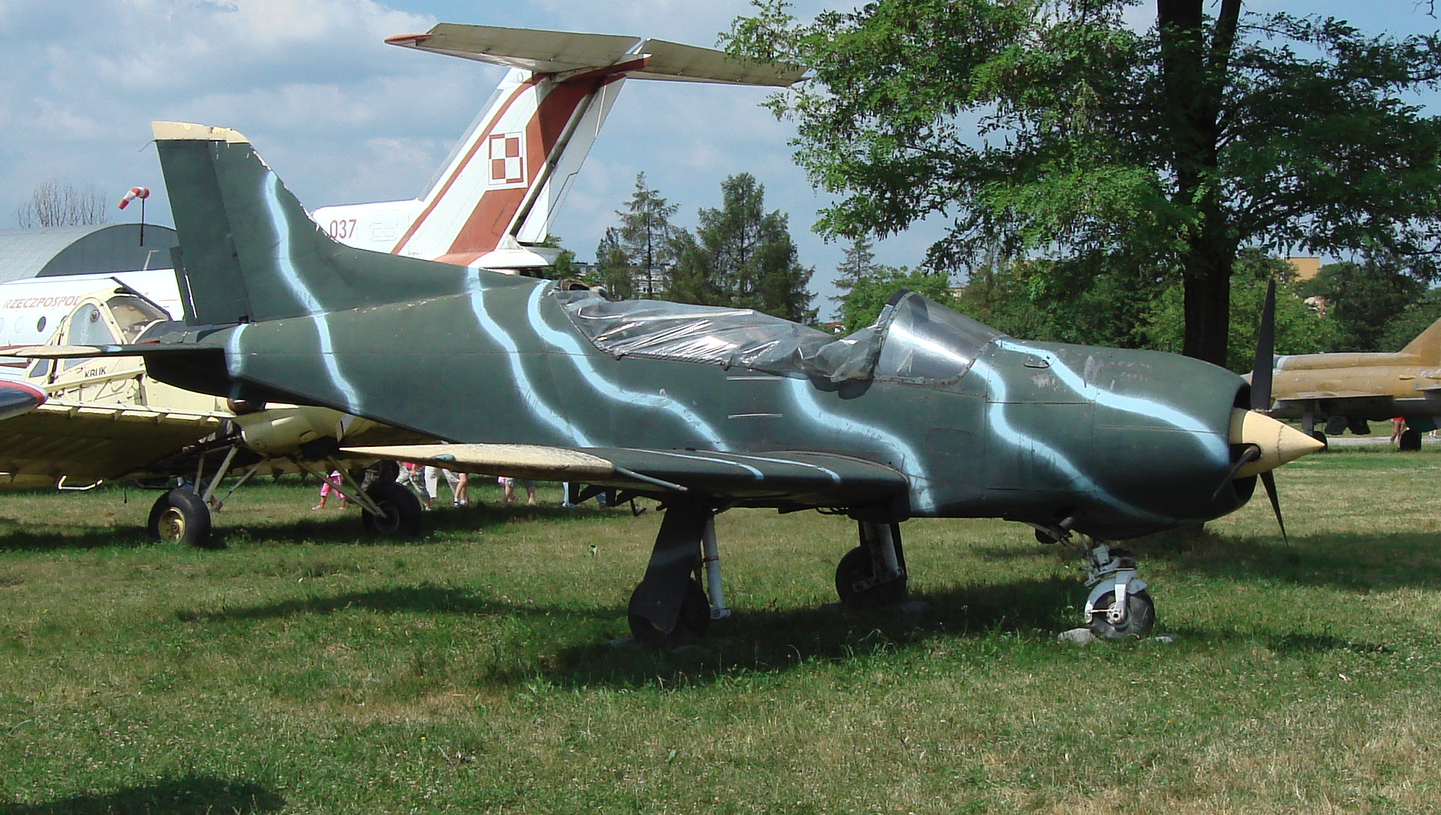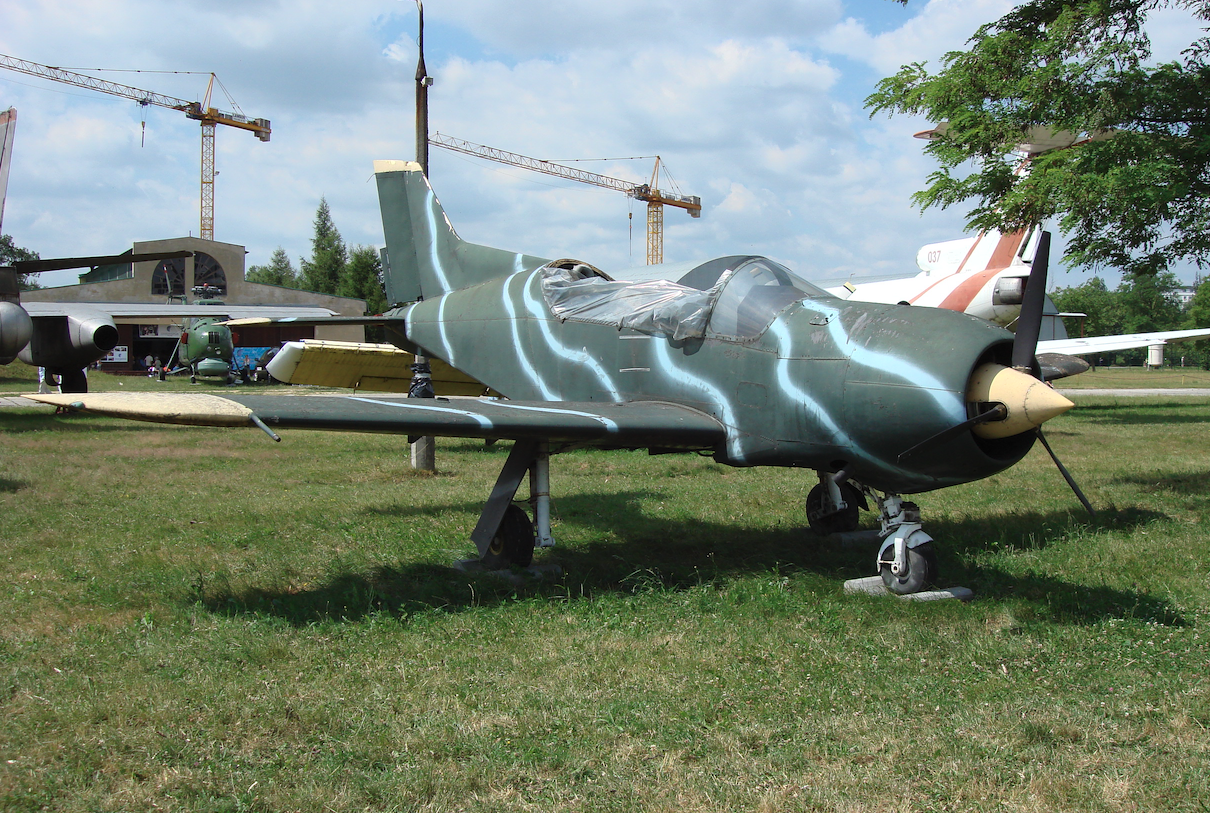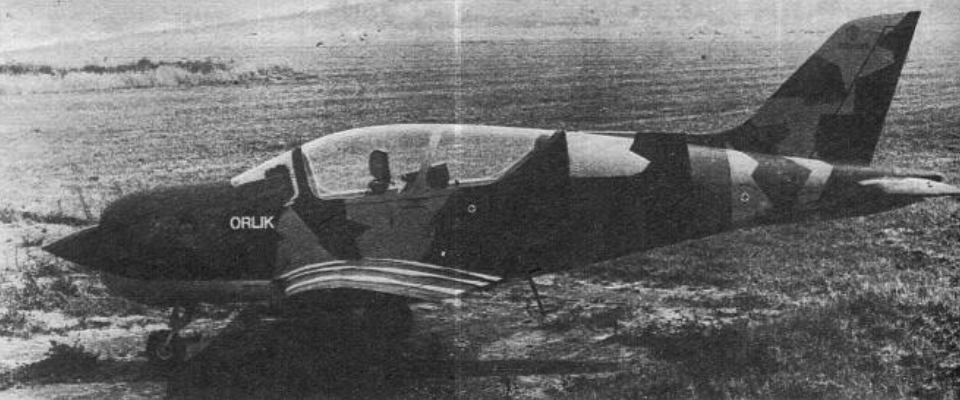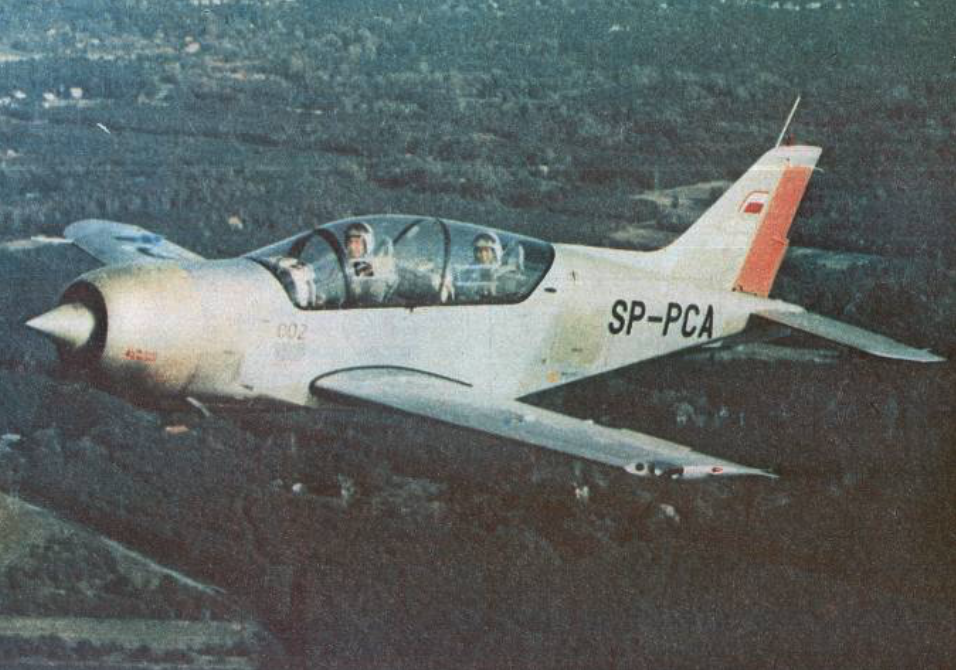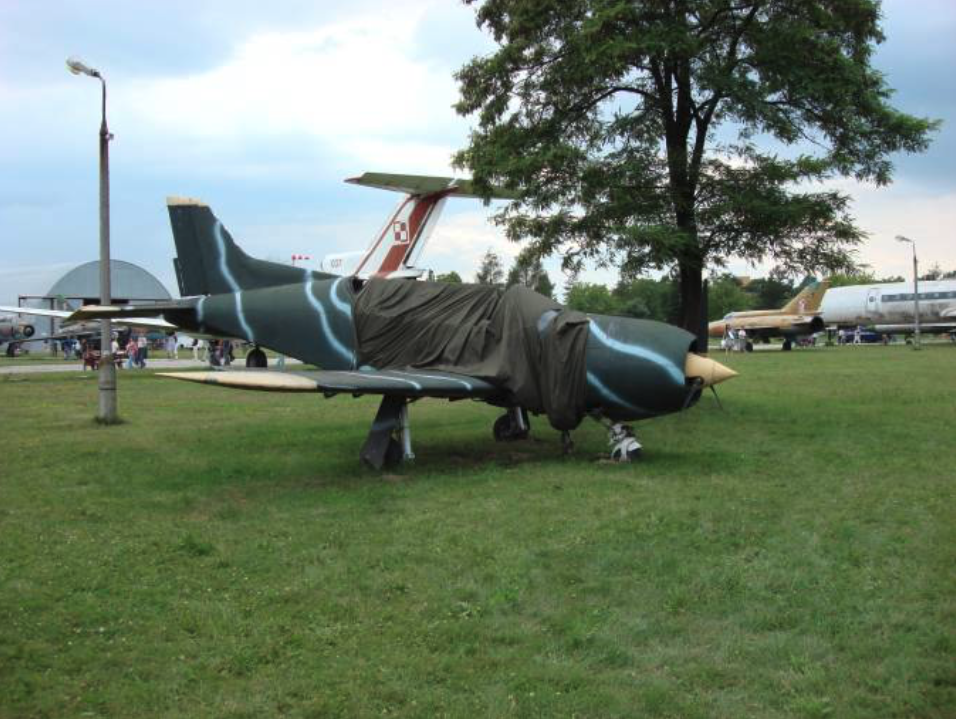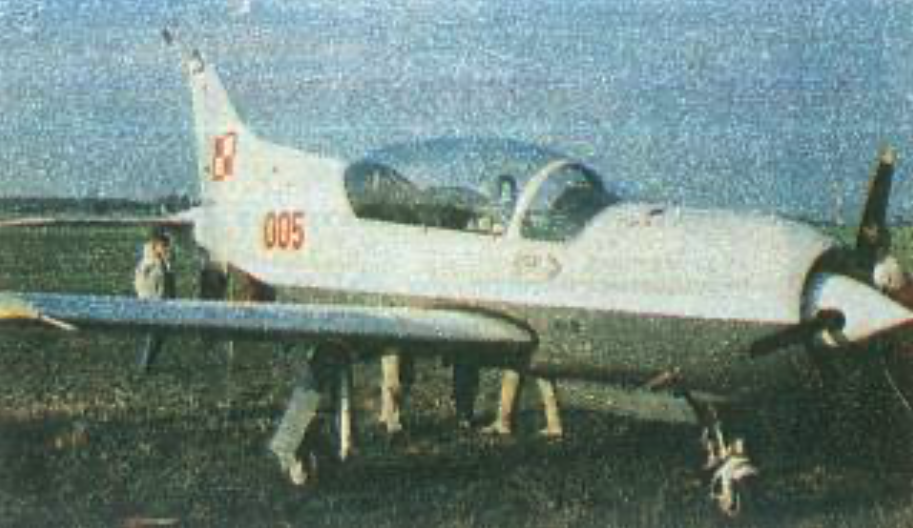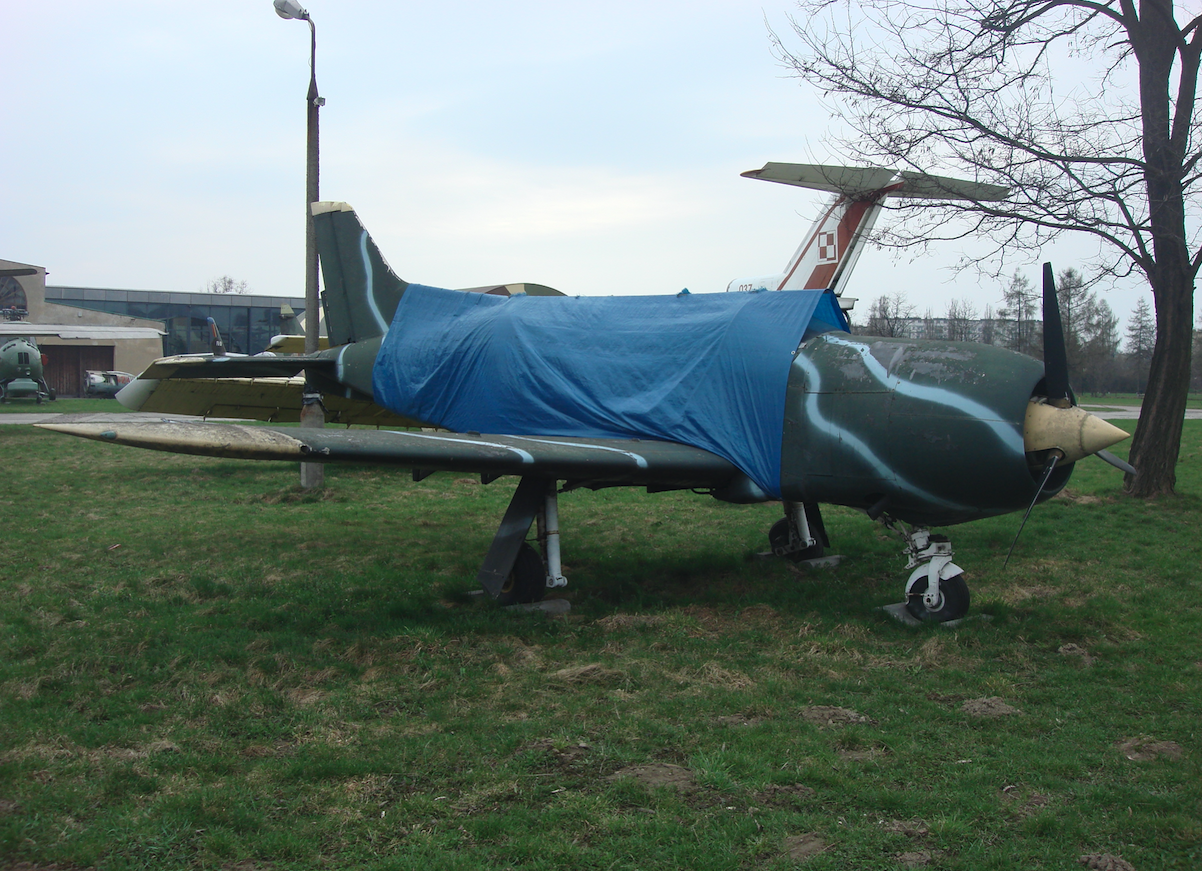Kraków 2008-09-05
271c Section 1984-10-12
PZL-130 Orlik, piston engine
Poland
History
Fake jet plane.
The fuel crisis in the world in the 70s forced governments of many countries to seek savings, even in military aviation. The search for aviation constructions cheaper to operate and, above all, burning less fuel was started.
For example, we will give some of the then planes and their fuel consumption on average for 1 hour of flight;
- Propeller CAP-10 – 38 liters of aviation fuel.
- Epsilon propeller – 55 liters of aviation fuel.
- Turboprop Cessna T-34 C – 160 liters of aviation kerosene.
- Turboprop Pilatus PC 7 – 180 liters of aviation kerosene.
- Jet Microjet – 160 liters of aviation kerosene.
- Jet Provost – 600 liters of aviation kerosene.
- Jet Macchi 326 – 600 liters of aviation kerosene.
- Jet Cessna T-73 B – 700 liters of aviation kerosene.
- Jet Fugue CM 170 – 700 liters of aviation kerosene.
- Jet Alpha Jet – 1,000 liters of aviation kerosene.
- Jet T-33 – 1 500 liters of aviation kerosene.
It is not surprising then that it was decided to build propeller-powered aircraft with the features of jet aircraft.
Another thing is that, training a combat aircraft pilot must take place in a specific system. The trained pilot is gradually switching to the next types of aircraft. To make it easier, the basic and transition types must have the characteristics of a target (combat) aircraft. For example, in terms of the arrangement of instruments in the cabin.
Flight simulators have also become part of the training system, which further reduce costs and accelerate training. The simulator can "fly" even when the real weather is not volatile.
PZL-Okęcie
At the end of the 1970s, modernization of the training process was also undertaken in Poland. They started to create a system whose basic elements became; aircraft, ground simulator and aircraft diagnostic device. The whole was initially called SYSTEM PZL-130. The main constructor of the PZL-130 aircraft and the creator of the Polish training system was MSc. Eng. Andrzej Frydrychewicz. A little later, the whole System was named PZL-College, the PZL-130 Orlik aircraft, the PZL-Professor ground simulator, the PZL-Inspektor ground diagnostic device.
PZL-Profesor ground simulator was built based on an electronic microprocessor. The system is simply an extensive TV game with good reproduction of simulated objects. The ground simulator is no longer a trainer of the Link Trainer type known from aeroclubs, but a device based on a digital counting machine with an environment visualization system in the form of a digitally generated image for the take-off and landing range. The basis is a microprocessor, similar to the one used in the ZX-81 Spectrum mini computer. The computer is controlled by a program recorded on a cassette tape and additionally impulses caused by an instructor who supervises the training.
The student sits in a model of the Orlik’s cabin. He has a screen in front of him with a moving picture of the terrain. The second screen below shows the on-board instruments. The student has at his disposal: joystick, pedals, throttle lever and other instruments necessary for take-off and landing.
The simulator familiarizes the student with the reactions of the aircraft and is to develop and consolidate specific habits in the student, both in typical conditions as well as abnormal and emergency situations.
The introduction of electronics similar to those already available in the television learning process of pilotage is only a general term, because it is intended to reduce the cost of training by building new generation simulators, much cheaper than those built so far.
Work on the simulator was completed in 1986.
The diagnostic device determines; condition of engine, aggregates and airframe. The appropriate plug, with multi-core cables, is connected to the control and measuring apparatus. Based on the data that is stored in the processor’s memory, the scope of necessary repairs and calibration is determined.
The last element of the system is watching over the training process of individual pilots. And this topic uses a computer.
Each pilot-student has systematically entered partial training results, hours spent in the simulator and on the plane. Passing or failing to complete individual tasks. Comparison of training effects with the adopted formula and between individual pilots contributes to better management of the overall training process. Limits subjective pilot rating.
And one more new element, i.e. training. It is hard to imagine that the student on a free afternoon for additional training could take flight on the TS-11 Iskra. On the PZL-130 Orlik, this is fully possible and will not cause excessive additional financial burden. And here another advantage of the PZL-130 aircraft over the jet aircraft is visible.
In Poland, it was not hidden that in the future they counted on exporting the aircraft and the entire system. At that time, Poland exported a lot, but it was mainly raw materials and fewer were technically developed products. At that time, no Comecon country had and developed a similar system, which is why future exports were as real as possible. In addition, PZL Okęcie wanted to return to good tradition, i.e. the construction of training and training aircraft.
When starting the construction of the PZL-130 SYSTEM, the design office was aware that, without cooperation with the future user, work could not be successful. Therefore, the army (MON) delegated a group of engineers to the design office, which included specialists from the Air Forces. Professor Tadeusz Sołtyk was invited as a consultant.
Chief designer – Andrzej Frydrychewicz. The constructor conducting the production of prototypes was MSc. Tomasz Wolf The silhouette and the interior of the aircraft were developed by a specialist in the field of stylization and ergonomics, Jacek Kończak, MA.
Among experienced constructors, with about 30 years of experience, we can mention mgr mgr inż. Eng .; Kazimierz Dąbrowski, Anatol Kossowski, Stanisław Malewski, Wojciech Międlar, Stanisław Janicki, Włodzimierz Grzęczewski, Andrzej Kardymowicz, Lech Jarzębiński, Tadeusz Jurkiewicz, Wojciech Puszcz, Norbert Maciejewski, Brunon Biernacki, Jan Tomaszewski, Stanisław Jabłoński.
Younger generators; Władysław Skorski, Tomasz Makowski, Marek Sadkowski, Ryszard Żuchowski, Artur Ostrowski, Witold Wiraszka, Lech Stangret, Tomasz Kubicki, Dariusz Pawełek, Jacek Kowalski, Stanisław Sztenzel, Roman Rogalski, Andrzej Mamona, Krzysztof Guerquin, Adam Kwieciński, Andrzej Denisiewicz, Janusz Rajchert , Jacek Janowski. Many of them were graduates of the Warsaw University of Technology from 1981–1983.
Starting work on the PZL-130 aircraft, they also counted on the future operation of the aircraft in organizations outside the army, mainly thinking of the PRL Aeroclub.
Concept PZL-130 Orlik.
By analyzing the concepts of the aircraft, the designers tried to create a propeller plane simulating a jet aircraft. The plane was supposed to have hang glider properties more similar to a jet plane than a classic piston plane. PZL-130 Orlik during take-off, landing and maneuvers in the air was to have the behavior of a jet aircraft. Some aerial figures made in the air were to be identical to those made on jet planes. The plane was to be better than similar structures already existing in the world.
The Orlik aircraft owes its pilot features to a small wing extension of 5.2, with a laminar profile and optimal convergence. The surface load was optimally selected. A value of 118 to 130 kg / m2 was assumed. The power load was set at 5.5 – 6.0 kg / kW. Even the adoption of new school-combat and combat machines for the equipment will not reduce the value of the Orlik aircraft, as it has the ability to change appropriate systems, build new installations, and assemble new instruments to suit changed needs. The cabin was designed so large that in the future there would be no problems with installing new devices. These modifications are made possible by the modular design of the cabin, especially the dashboard panels. Electrically adjustable seats and adjustable pedals provide comfort for pilots from 150 cm to 200 cm tall. Five-point aerobatic seat belts.
The first version of the Orlik aircraft under development was consistent with the TS-11 Iskra. Although nothing prevented the aircraft from being adapted to the next type. They even hoped for the possibility of switching the trained pilot from the Orlik aircraft to the combat aircraft right away, which from today’s perspective was unreal.
The landing gear of the aircraft was carefully designed to allow high-speed landing and to forgive the mistakes of trained pilots.
The PZL-130 Orlik aircraft consists of about 2,100 parts, including an airframe of about 450 parts. To reduce costs, many of these parts come from existing and manufactured in Poland aircraft and helicopters. The number of these elements was over 520 parts. Some sources even reported 700 parts.
Attention was paid to the arrangement of system components and aggregates that require frequent maintenance so that mechanics do not interfere. It is known that mechanics also form an opinion about an airplane.
Basic assumptions of WTT (tactical and technical conditions).
A wing with a small elongation, with an extended range of usable inclination angles, with characteristics accustoming to controlling the power of the engine at the landing approach. Strong retractable undercarriage, allowing take-off and landing at higher forward and vertical speeds.
High-speed metal propeller with variable pitch, generating small gyroscopic moments. Design and ergonomics of the crew cabin made in the style of a military (combat) aircraft. The cabin as large as possible. The instrument panels of the modular structure have the possibility of easy reconstruction for the assembly of new instruments and avionics sets. The rear cab instructor has the ability to imitate various emergency situations.
PZL-130 Orlik in civil version.
From the beginning, the version of the Orlik aircraft for Aeroclubs was taken into account. Its airframe was to differ slightly from the military version. Wings with a larger span and at the same time greater elongation. The wing tips were to be changed. An engine with less power, but more economical. The aircraft was to be able to aerobatics and flights in difficult weather conditions. Of course, everything depended on the attitude of the Aero Club of the Polish People’s Republic. The PZL-130 Orlik aircraft version for the Aero Club was not created.
PZL-130 in the state rank.
In the command-and-control economy of Poland, in order for any planned aircraft to build a prototype and fly it, it had to become a state. This involved financing. None of the Polish companies at that time had their own funds for projects. PZL-Warsaw-Okęcie’s efforts to place the project in the central plan lasted from 1978 to 1981.
In 1981, the program codenamed "Subject" received the first funds. The offer design of the Orlik aircraft was made in 1979-1980. In the autumn of 1981, the technical design was started.
Construction of prototypes. 1982.
It began with the construction of a life-size aircraft model. It was ready in July 1982. The model was painted in protective colors to prove that the Orlik plane looks good in a "uniform". A fictitious board number 0252 was painted on the model. The use of a piston engine PZL-Franklin 6A-350-C1 with a power of 162 kW (220 HP) was envisaged, but it soon turned out that the engine power was too low and another drive had to be looked for.
The prototype series of PZL-130 aircraft consisted of four machines, No. 001, 002, 003, 004. The first prototype No. 001, as usually non-volatile, was intended for fatigue tests. Prototype No. 002 received a piston 9-cylinder Viennese M-14 Pm star engine with 243 kW (330 hp), with a three-blade adjustable propeller. The construction of the aircraft was completed on 1984-09-03.
The first flight of the PZL-130 Orlik aircraft. 1984.
On 1984-10-12, the first flight was made by the first flying prototype of the aircraft designated PZL-130 No. 002 registration SP-PCA. The pilot was the experimental pilot PZL-Okęcie Witold Łukomski. The day of October 12 was chosen especially because it was then celebrated as Polish Army Day.
On 1984-12-29, the third volatile prototype was flown as the second, i.e. PZL-130 No. 004 registration SP-PCC.
On 1985-01-12, for the first time a second flight prototype PZL-130 No. 003 SP-PCB registration performed.
After the first flights, the pilots said that the plane is suitable for initial training, i.e. for novices. But according to the designers, there was no need to use the PZL-130 aircraft for basic training, which is technically very developed. After all, the aircraft has a retractable landing gear, extensive equipment, and therefore elements unnecessary for a newcomer.
According to the creators of the training system, 1 – Koliber, 2 – Orlik, 3 – TS-11 Iskra or its more modern equivalent (works on the I-22 aircraft were underway at the time), a higher-class combat or civil aircraft (multi-engine).
At that time, the Orlik’s deployment to service seemed undisturbed. No aircraft threatened the PZL-130 because it filled the gap. According to the designers, the Orlik aircraft was excellent for training aeroclub pilots who were going to devote themselves professionally to flying in civil aviation.
Presentation of the PZL-130 Orlik. 1984-1985.
At the end of 1984, the first photos of the new PZL-130 aircraft were demonstrated to the public by publishing them in the weekly Skrzydlata Polska and other colorful weeklies. In the 80’s, the piano PZL-130 a lot and good. Success was eagerly presented, although the difficulties were carefully hidden, which was the rule at that time.
This large amount of information about the new aircraft is not surprising if we consider that it was supposed to become an export item. Already in 1985, the PZL-130 aircraft No. 004 SP-PCC was shown at the Le Bourget Aerospace Salon in Paris. The machine was demonstrated only at a static exhibition. The plane aroused great and kind interest.
Also in this 1985, aircraft PZL-130 No. 003 registration SP-PCB, in the so-called Chinese camouflage, was shown in China in Beijing at the military equipment exhibition.
1986.
In 1986, the Polish Army continued to consider the concept of a new training for military pilots. Even the concept of three-step pilot training has already been formed; this was connected with the demand for three types of aircraft: selection training (PZL M-26 Iskierka), basic (PZL-130 Orlik) and advanced (PZL I-22 Iryda). However, as it turned out, this was not the final concept, and its main disadvantage was the large number of types, and thus you did not achieve the basic goal of reducing costs.
In 1986, work was underway at PZL-Okęcie to modernize the PZL-130 aircraft. The main topics should be included; new piston and turboprop engines, new propellers, modified boxes by adding new tips and thus increasing the area and span to 9.0 m.
Work continued on using lightweight reclining seats in the cabin.
Of course, the new powertrain was given the most attention and energy. The 9-cylinder star piston engine Wiedieniejew M-14 Pm / AI-14 was definitely obsolete. It was used to propel Gawron, Wilga, and Jak-12 aircraft. The plant in Kalisz undertook to modernize this construction and developed a PZL K-8 AA engine with 210 kW (290 hp). A new propeller is also provided for the new engine.
But already at that time clear signals were coming from the army (MON) that the Orlik aircraft should be equipped with a turboprop engine.
In the second half of the 1980s, the Polish Army ordered a short series of PZL-130 Orlik with piston engines and PZL-Okęcie started their production.
The first two were given the numbers 005 and 006. The first one received the M-14 Pm / AI-14 engine and was flown on 1988-02-19. The second with the PZL-Kalisz K-8 AA engine made the first flight on 1988-03-19.
However, the Ministry of National Defense was not satisfied with these planes, especially the engines. In 1989, military tests of Orlik aircraft No. 002, 005, 006 were carried out. As a result, the Ministry of National Defense withdrew from the initial order of 25 copies and began the development of new WTT for turboprop aircraft.
Written by Karol Placha Hetman
Kraków 2008-09-05
271c Section 1984-10-12
PZL-130 Orlik with a piston engine
Poland
Cnstruction
Construction PZL-130
Single-engine, two-seater training and training aircraft, made of metal. A piston engine in a star system. NACA 642215 wing modified to obtain a constant chord of the ailerons and flaps. Rise +5 degrees, wedge angle at the hull 0 degrees, geometric degree of rotation 3 degrees. Metal construction, non-split, caisson, multi-longitudinal, riveted caisson and welded flow part. Frize darts tilted 20 degrees up and 12 degrees down. Slotted flaps swing out to take off 10 degrees for take-off and 40 degrees for landing. Glass-epoxy composite tips.
Fuselage. Flat from below. Elliptically vaulted from above. Metal half-shell construction, riveted from welded components. Cabin glazing made of plexiglass glued to glass-epoxy composite frames. The cab cover opens to the right side. The cab cover may be rejected in an emergency. To facilitate boarding, a fixed footrest attached to the fuselage was used to stand on the left wing. Two-seater cabin in tandem arrangement. Rear seat with slight elevation. The seats are electrically adjustable and are adapted to use both back and seat parachutes.
Classical formation, well ahead vertical horizontal. Metal construction partially welded. Rudder tilts 30 degrees in both directions. The horizontal tail span is 3.50 m.
Three-support chassis with front wheel, retractable in flight. All wheels single. Front telescopic chassis with half-fork wheel and lateral vibration damper. Main landing gear wheels on rocker arms with hydraulic disc brakes. Oil and gas shock absorbers. Low-pressure tubeless tires. A parking brake. The chassis base is 2.22 m. The main chassis spacing is 3.10 m.
Control. Pusher ailerons with torsion tube at the starboard side of the hull. The elevator is moved pusher-rope. Rudder moved by cable. Flaps, balancing flaps and curtains for the engine cooling air intake. Electric control. The drive unit is controlled by double-acting flexible tendons (arens). Steering lever sectors.
The instrument panel contains; magnetic compass, speedometer, altimeter, artificial horizon, gyrocopter, gyrometer with bendmeter, variometer, clock, manovacometer, engine control indicator which shows fuel pressure, oil pressure, oil temperature. Other instruments are; tachometer, engine head temperature thermometer, carburetor thermometer, two fuel gauges, carburetor thermometer, stall indicator, accelerometer, fault signaling system, flap position indicator, chassis position indicator, rocket indicator, pneumatic system main pressure gauge, pneumatic emergency circuit pressure gauge, brake pressure gauge .
Engine PZL-130.
9-cylinder star engine of the Viennese type M-14 Pm with 243 kW. Pneumatic engine starting. Adjustable three-blade metal propeller. The propeller diameter is 1.95 m. Ultimately, the PZL-Kalisz K-8 AA engine was to be used, which was a modernized M-14 Pm engine.
Aircraft installations PZL-130
Fuel – 4 integral tanks in the caisson box with a capacity of 2 x 100 liters and 2 x 110 liters. Expenditure tank with a capacity of 9 liters in the fuselage.
Pneumatic. The pneumatic system is two-circuit. Basic and emergency circuit. Working pressure 4.9 Mpa.
Electric. Electrical installation with a voltage of 24/28 V. A 3 kW generator. 24 V / 18 Ah battery.
Plumbing system. Equipped with a 26-liter oil tank, cooler with thermostat.
Avionic.
The aircraft is equipped with a set of pilot-navigation instruments and engine control. Installation control instruments set. Failure signaling system. UHF radio station, radiocompass, on-board telephone, rocket launcher, fire extinguisher, first aid kit. The aircraft has the option of installing a radio altimeter.
Armament.
The plane was equipped with two catches of suspended light armament, which were placed under the wings. They can be containers with non-guided missiles or light bombs of various types.
Data T-T PZL-130. 1984.
- Span 8.00 m
- Length 8.45 m
- High 4.00 m
- Bearing area 12.28 m2
- Lengthening of the lobe 5.21
- Curb weight 950 – 1,110 kg
- Total weight 1 500 kg
- Maximum weight 1,600 kg
- Load weight 250 kg
- Fuel weight 420 kg
- Load capacity of 130.1 kg / m2
- Engine power load up to 6.04
- Maximum speed 340 – 380 km / h
- Climbing speed 7.0 – 7.4 m / s
- Landing speed 116 km / h
- Cruise speed 316 km / h
- Maximum range 1,415 – 1,460 km
- Ceiling 4,200 – 7,000 m
- Run up to 300 m
- Run to stop 240 m
- M-14 Pm engine with 243 kW
Data T-T PZL-130. 1986.
- Span of 9.00 m
- Length 8.45 m
- High 4.00 m
- Bearing area 12.80 m2
- Lobe extension 6.33
- Curb weight 1 112 – 1 147 kg
- Total weight 1 520 kg
- Maximum weight 1,600 kg
- Load weight 300 kg
- Fuel weight 420 kg
- Load capacity of the bearing surface 125 kg / m2
- Engine power load up to 6.04
- Maximum speed 340 km / h
- Climbing speed 7.1 m / s
- Landing speed 115 km / h
- Cruising speed 310 km / h
- Maximum range 1,430 km Ceiling 4,300 m
- Run up to 300 m
- Run to stop 240 m
- M-14 Pm engine with 243 kW
Written by Karol Placha Hetman
Kraków 2008-09-05
271c Section 1984-10-12
PZL-130 Orlik
Poland
Tally
- 000 – mockup. It was made in natural size in 1982. The model received multicolored (yellow-brown-blue) camouflage and fictitious nb 0252.
- 001 – non-volatile prototype. Designed for fatigue tests.
- 002 – the first volatile prototype. SP-PCA registration. He made his first flight on October 12, 1984. The pilot was Witold Łukomski. The aircraft is practically unpainted. Left in the color of natural duralumin sheets with anti-corrosion protection, therefore it looks as if it was painted with various shades of light yellow paint. Registration in black. Orange rudder, which indicates that it is a prototype.
- 003 – the second volatile prototype. SP-PCB registration. He made his first flight as the third Orlik on January 14, 1985. The plane received camouflage called Chinese. The whole plane is dark green with gray-blue veins. Airframe tips in yellow. In 1985 the plane was shown at the Beijing military equipment exhibition. After a series of tests, it was handed over to the museum in Czyżyny in the 90s.
- 004 – the third volatile prototype. SP-PCC registration. Flown on December 29, 1984. as the second Orlik aircraft. The whole plane was painted in navy blue. Registration in white. The orange rudder, which means that it is a prototype. Wing tips and horizontal tail also orange, which in the future has become a distinguishing feature of serial aircraft. In 1985 aircraft shown at the Paris Aerospace Salon. The aircraft was selected for the conversion of piston to turboprop propulsion. The Pratt-Whitney PT 6 A-25 A engine with 410 kW (550 HP) was selected, with a Hartzell HC-B3TN-3B / T10173K-11R three-blade propeller. It has three blades with variable pitch. In November 1985. the plane was sent by sea to Canada. The elements needed for reconstruction were made in Poland and sent by sea to Canada. They were; engine bed, engine covers, hydraulic system cylinders and others. The aircraft received new painting. The reconstruction was completed in mid-1986. The first flight, named Turbo Orlik (PZL-130 T / TP), was carried out on 13.07.1986, other sources state on 16.07.1986, and the pilot was piloted by the experimental pilot MSc. Jerzy Wojnar. The plane completely fulfilled its hopes. The Turbo Orlik promotion began with Colombia, which intended to mock 80 (!) Aircraft of this class. Unfortunately, during the demonstrations on 20.01.1987, due to a pilot error, there was a plane crash in which Bogdan Wolski – Turbo Orlik who was conducting trials and a Colombian aviation officer – died.
- 005 – pre-series. In the second half of the 80s, the Polish Army ordered a short series PZL-130 Orlik with piston engines and with an option for a total of 25 pieces. The first PZL-130 No. 005 received the AI-14 piston engine. The first flight on February 19, 1988. However, the Ministry of National Defense abandoned the admission of these aircraft after the attempts. The plane received in 1990. Walter turboprop engine. Designation PZL-130 TM. The aircraft was used for liaison flights in 23 EL (flight squadron) in Dęblin and 45 ELD (experimental flight squadron) in Modlin.
- 006 – przedseryjny. Należał do tej samej serii co nr 005. Wyposażony w silnik tłokowy PZL-Kalisz K-8 AA. Pierwszy lot w dniu 19.03.1988r. Podobnie jak nr 005 otrzymał w 1990r. silnik turbośmigłowy Walter. Samolot były wykorzystywany do lotów łącznikowych w 23 EL ( eskadrze lotniczej ) w Dęblinie i 45 ELD ( eskadra lotnicza doświadczalna ) w Modlinie.
- 007 – pre-series. Built from the beginning for turboprop propulsion. Walter M-601 engine with 550 kW power cooperating with the five-blade Avia VJ8.508E propeller. The first flight was carried out on 12.01.1989, and the pilot was the IL experimental pilot MSc. Jan Gawęcki. After completing numerous tests, the aircraft was handed over to the Air Force Academy in Dęblin as a non-volatile scientific aid.
- 008 – pre-series. The aircraft was designated PZL-130 TC No. 008 registration SP-WCA. The aircraft made its first flight on March 15, 1990, and then a whole series of tests were carried out, also in the 32 PLRT in Sochaczew. The plane was presented in Israel and South Africa.
- 009 – pre-series. The aircraft received the designation PZL-130 TB No. 009 and registration SP-PRF. Walter M-601 T engine with 551 kW (750 hp). It was completed in 1992. The aircraft has a wingspan larger by one meter. The cab cover has been enlarged and changed. The tip of the tail and many other changes have been changed according to the new WTT. The first flight took place on September 17, 1991. In this form, the aircraft was approved by the Polish Army and adopted as a basic training aircraft by the Polish Air Force and Air Defense. During difficult and dangerous tests on January 25, 1996. the machine was destroyed burying two pilots (?). Further attempts were made by copy No. 037.
- 010 – pre-prototype. The aircraft received the designation PZL-130 TC No. 010 with a P&W Canada PT6A-62 engine with 699 kW (950 hp). It is the equivalent of aircraft No. 011, but with much poorer avionics.
- 011 – pre-prototype (demonstrator). The aircraft received registration SP-PCE equipped with a P&W Canada PT6A-62 engine with a capacity of 699 kW (950 hp) and a four-blade Hartzell HC-D4N-2A propeller. The first flight was made on June 2, 1993. by J. Wojnar and T. Dunowski. The aircraft received the Bendix-King digital avionics, integrated data bus, on-board computers, HUD Flight-Vision and was equipped with multi-functional displays next to the classic pilot devices, Martin-Baker Mk CH15A thrown seats. The aircraft was also equipped with light suspended armament on six sub-wing nodes with PZL-UBP beams. About 2005 the plane went to the Museum in Czyżyny without the engine and covers.
- 012 – The first serial from a batch of 9 machines (No. 012-020). They were designated PZL-130 TB. The aircraft received gray camouflage, yellow wing tips and a propeller hubcap, three-digit red board numbers and checkerboard (old model). The first flight of this copy took place on August 21, 1992.
- 013 – Second PLZ-130 TB. This copy with SP-PCF registration was presented at the Paris Air Show in 1993. In 1994. in operation of the Polish Army, without registration, and with the number 013. Later it was handed over to the Polish Aviation Museum in Czyżyny.
- 014 – PZL-130 TB. Later brought to the PZL-130 TC-I standard.
- 015 – PZL-130 TB. Later brought to the PZL-130 TC-I standard.
- 016 – PZL-130 TB. Later brought to the PZL-130 TC-I standard.
- 017 – PZL-130 TB. Later brought to the PZL-130 TC-I standard.
- 018 – PZL-130 TB. Later brought to the PZL-130 TC-I standard. In 1995 tests were carried out on suspended equipment under the wings. This aircraft was equipped with PZL-UBP beams enabling suspension of containers from km, npr, bombs or additional tanks. However, the adopted standard was different from the NATO standard. In 2003 shown in Mierzęcice (Pyrzowice).
- 019 – PZL-130 TB. Later brought to the PZL-130 TC-I standard. In 2005 shown in Pruszcz Gdański.
- 020 – PZL-130 TB. Later brought to the PZL-130 TC-I standard.
- 021 – pre-series PZL-130 TC-I. Another PZL-130 TB aircraft, which received class 0-0 ejection seats, improved avionics, checkerboard in a new design, orange-reflective wing tips and tail and several other minor changes. Over time, the previous PZL-130 TB was brought to the PZL-130 TC-I standard. It was a catastrophe, but no further data is available.
- 022 – pre-series PZL-130 TC-I. Identical to No. 021. Treated as the first aircraft of the second series (No. 022-027) and transferred to the army in Radom. In 1995 shown in Dęblin. In 2003 shown in Radom.
- 023 – PZL-130 TC-I. In 2006 shown in an unusual place in Warsaw in front of the Sobieski Hotel.
- 024 – PZL-130 TC-I. In 1994 shown in the press as one of the first PZL-130 TC-I.
- 025 – PZL-130 TC-I. In 1999 shown in Radom. In 2005 shown in Dęblin.
- 026 – PZL-130 TC-I.
- 027 – PZL-130 TC-I. In total, there were already 14 aircraft in Radom.
- 028 – PZL-130 TC-I. In 2003 shown in Radom.
- 029 – PZL-130 TC-I.
- 030 – PZL-130 TC-I.
- 031 – PZL-130 TC-I.
- 032 – PZL-130 TC-I.
- 033 – PZL-130 TC-I.
- 034 – PZL-130 TC-I. On October 11, 2001 has a catastrophe.
- 035 – PZL-130 TC-I. In 2004 shown in Pruszcz Gdański.
- 036 – PZL-130 TC-I. On May 9, 2001 has a catastrophe.
- 037 – PZL-130 TC-I. After the crash of machine No. 009 in 1996 took over performing further necessary tests. It underwent tests of suspended tanks. As the second it was rebuilt to the version PZL-130 TC-II and flown in 2007.
- 038 – PZL-130 TC-I.
- 039 – PZL-130 TC-I. On 5.01.2002 has a catastrophe.
- 040 – PZL-130 TC-I.
- 041 – PZL-130 TC-I. In 2004 shown in Malbork.
- 042 – PZL-130 TC-I.
- 043 – PZL-130 TC-I.
- 044 – PZL-130 TC-I. In 2007 shown in Radom.
- 045 – PZL-130 TC-I.
- 046 – PZL-130 TC-I. In 2004 shown in Malbork.
- 047 – PZL-130 TC-I. As the first rebuilt to the version PZL-130 TC-II. First flight on October 8, 2003
- 048 – PZL-130 TC-I.
- 049 – PZL-130 TC-I.
- 050 – PZL-130 TC-I. In 2004 shown in Malbork.
- 051 – PZL-130 TC-I. One of the last serial PZL-130 Orlik. In 2005 shown in Radom. On August 30, 2008 shown in Minsk Mazowiecki in 23 Blot.
- 052 – PZL-130 TC-I. Last Serial.
Airplane versions PZL-130 Orlik:
- PZL-130 – prototypes with the M-14Pm engine (PZL K8-AA)
- PZL-130 T / TP – prototype with PT6A-25A / 25C engine with simple western avionics
- PZL-130 TB – serial aircraft for WLiOP (Walter M601T) – converted to TC-I
- PZL-130 TC – export version (PT6A-62) with rich avionics equipment
- PZL-130 TC-I – serial version for WP (M 601T)
- PZL-130 TC-II – prototype of the serial version for PSP (PT6A-25C)
- PZL-130 TC-III – design version with glass-cockpit avionics (PT6A-25C), initially designated TC-II
- PZL-130 TD – version design with PT6A-25C engine and simple western equipment
- PZL-130 TE – version design with PT6A-25A engine and simple western equipment
- PZL-130 TM – designation of information series for Polish aviation (M-14Pm / M 601E)
- PZL-130 H – aircraft design for Hungarian aviation (M 601T)
Written by Karol Placha Hetman

